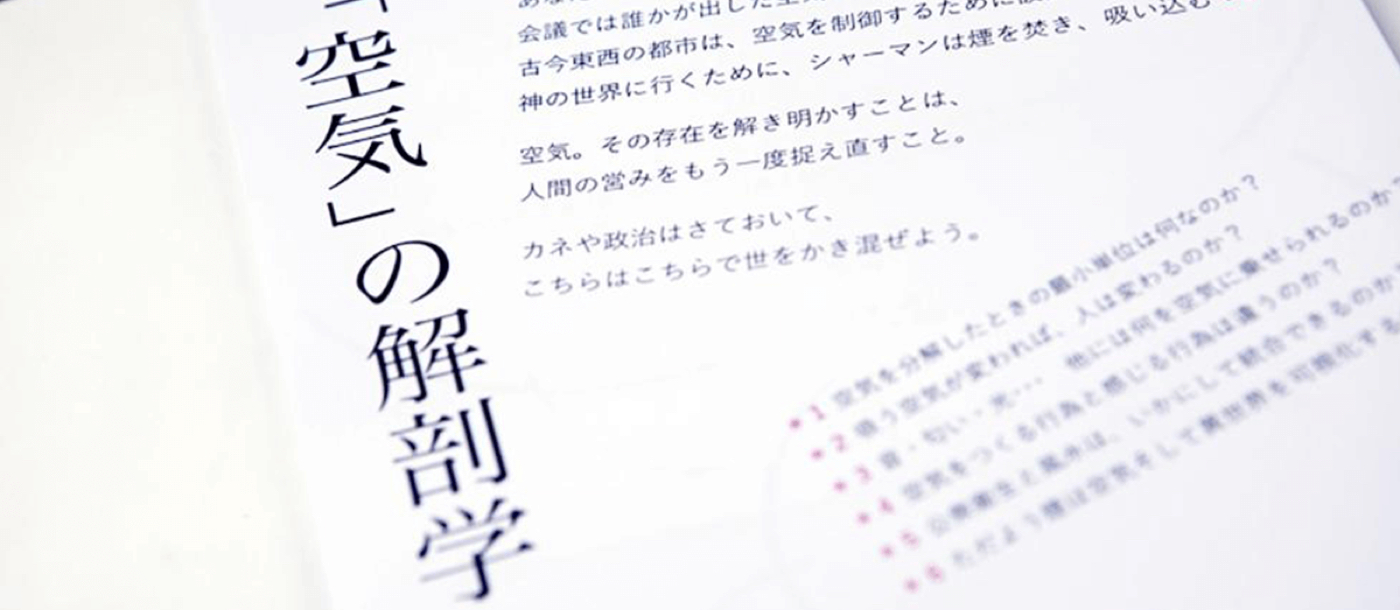
What is “Air”? Exploration of New Business Opportunities
Outline
Examination of “Air”
In the modern age, things are increasingly complicated and rapidly changing. Responding to market demands only brings us rehashes of existing products, making it difficult to create new value with a social impact.
What is important is to have an essential “question” to confront society, and to plot a “proper process” to seek an answer. Polémica—a collaborative service of WIRED JAPAN and Loftwork that launched in 2016—is a program for companies that desire to create the future, and supports a process of devising a proper question and seeking an answer.
In early 2017, this project was launched as the second version of Polémica. Company A—an explorer of new future business possibilities in a variety of areas—consulted with us, and this exploration program was begun for the question of “what is air” beyond existing business domains.
Summary
- Content
Formulation of opportunity areas, while looking into the future
Research for establishing opportunity areas
Workshop planning/design
Development of research report/tools - Setup
Client company name: Undisclosed
WIRED: Kei Wakabayashi, Yosuke Kawamura, Shinya Yashiro, and Asuka Kawanabe
Loftwork: Chiaki Hayashi, Michiko Wakimizu, Mao Tada, and Satoko Kitajima
Center for the Promotion of Interdisciplinary Education and Research, Kyoto University: Naoki Miyano - Period
February-June, 2017 - Related link
Polémica—a program for companies that desire to create the future, in which WIRED JAPAN and Loftwork support a process of devising a proper question and seeking an answer
Outputs
Playing Cards for Firmly Comprehending the Complex and Multilayered Concept of “Air”
Some of the concepts around “air” that were obtained from a workshop could not be expressed in a two-dimensional system—unlike what project members had envisioned at first. Various concepts had a nested structure, and the hierarchical structure varied depending on the person who defined it.
Therefore, Idea Cards were designed as a final output, instead of a report booklet or video, enabling various workers of Company A to use them for ideation and validation in the future. The cards were designed with flexibility and extra margins, leaving room for various interpretations and new ideas, depending on who will use the cards or how the cards will be combined.
The Idea Cards consist of about 100 cards, categorized into six groups: concept, characteristics, behavior and condition, perception of air overseas, findings through conversations, and findings through books. New findings and ideas obtained within Company A can be written down onto the empty cards. Surprising questions and perspectives may arise by randomly arranging the cards and examining their correlations. Company A plans to continue utilizing the cards, in order to comprehend the complex and multilayered concept of “air.”

Process
Pursuit of the Future that Cannot be Envisioned with Conventional Marketing, Such as Market Needs Analysis, While Setting Aside Existing Businesses and Existing Value Provision
Project Design and Area (Theme) Formulation
Repetitive discussions were held between the three companies during the project design phase, identifying an area for pursuing the future that cannot be envisioned with conventional marketing, such as market needs analysis, while setting aside existing businesses and existing value provision of Company A.
“Air”—a broader concept that includes the existing businesses—was set as a research theme. Since there was no cross-sectional and comprehensive research and literature on air, all project members conducted multidisciplinary and cross-sectoral literature searches in science, society, religion, language, culture, etc., and deepened our study.

Literature Search
About 40 selected publications from a wide range of themes (e.g., classic, novel, history, philosophy, culture, science) were read carefully. In the course of research, “discoveries and findings” and “hypotheses” that arose from them were summarized.

Workshop with 20 researchers of Kyoto University
A two-day workshop called “Anatomy of Air” was held in collaboration with the Center for the Promotion of Interdisciplinary Education and Research, Kyoto University. Active researchers in various academic disciplines, including experts from areas other than air-related areas, were questioned on “what is air (for humans).”
For conducting the workshop, the participants were given six questions that were derived from the literature search to provoke active discussions. Understanding of the big theme of “air” was deepened by discussions with an intentional pre-established disharmony.
- What is the smallest unit of air when it is broken down?
- Does a person change after breathing different air?
- What can air carry other than sound, scent, and light?
- Is an action of producing air and feeling air different?
- How can we integrate public health with Feng Shui?
- oes drifting smoke visualize air and different worlds?


Verbalization/Structuring of Workshop Findings
One day after the workshop, the project members wrapped up the hypotheses and supporting data from the workshop. Information that would provide hints for the big question of “what is air?” were extracted from numerous attached sticky notes, and verbalization and structuring exercises were conducted.
As a result of integration, “air” was re-comprehended as several concepts, and we defined a perspective to understand “air”—a substance that we unconsciously and consciously feel the existence of in our lives.

Member
Next Contents
















